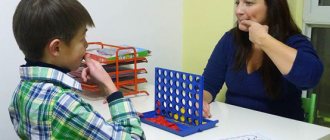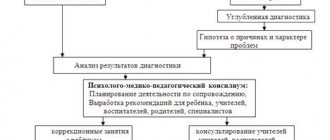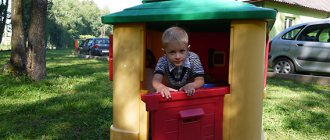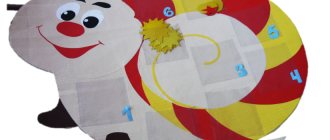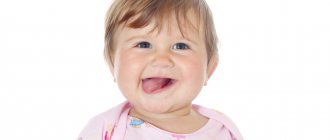Speech therapy work at school (from personal work experience)
The essence of the organization of speech therapy work is determined by the instructional letter of the Ministry of Education of the Russian Federation dated December 14, 2000 No. 2. “On the organization of the work of the speech therapy center of a general education institution.” This letter determines the procedure for performing the work of a speech therapy center as a structural unit of a state municipal educational institution. In accordance with this instruction, the main tasks of the speech therapy center are:
- Correction of violations in the development of written and oral speech of students;
- Timely prevention and overcoming difficulties in students’ mastery of general education school programs;
- Explanation of special knowledge on issues of speech therapy among teachers, parents (legal representatives) of schoolchildren with various speech disorders.
In accordance with the letter from the Ministry of Education, the tasks of the correctional work of a speech therapist at a general education institution include:
- Examination and selection of students into speech therapy groups;
- Conducting corrective speech therapy classes;
- General speech development of schoolchildren;
- Formation of speech prerequisites for mastering literacy, programs in the Russian language, mathematics, as well as other subjects;
- Popularization of speech therapy knowledge.
Students are enrolled in the speech therapy center after conducting a diagnosis of speech activity in the period from September 2 to September 16, with the completion of an examination protocol for each student. After the examination, groups of students are formed to conduct classes in accordance with speech impairments. Classes are held both in groups and individually 2-3 times a week.
In individual lessons, speech therapy work is carried out to correct sound pronunciation disorders in children. The means of speech therapy is a special speech therapy technique for correcting sound pronunciation, this is, first of all, a correctly selected and compiled system of speech exercises and a system of articulation gymnastics. In some cases, probe massage techniques are additionally used in classes.
Due to the fact that speech itself is associated with the movements of the speech apparatus, articulatory gymnastics, which is used when producing sounds, but sometimes it is also used at the stage of automating sounds, occupies a large place in speech therapy correction work for violations of sound pronunciation. The importance of articulatory gymnastics in correcting sound pronunciation is fully justified, since the pronunciation of sounds in speech is a complex motor skill.
The goal of articulatory gymnastics is to develop correct, full-fledged movements of the organs of articulation, which are necessary for the correct pronunciation of speech sounds, as well as to combine simple movements of the organs of articulation into complex articulatory structures of various speech sounds.
Depending on the group of sound or sound disorders, one or another set of articulation exercises is compiled. These exercises can be silent, i.e. without the inclusion of voice, as well as with the participation of voice.
The exercises usually begin with imitation movements, i.e. the speech therapist shows, and the child tries to repeat after him, as well as when performing exercises with the help, i.e., movements made with the mechanical assistance of the speech therapist (cleanly washed hand or finger of the speech therapist in a fingertip or latex gloves, and then the child himself, disinfected medical wooden spatulas or special speech therapy probes for sound production).
Passive movements gradually, with daily training, are transferred into passive-active movements, and then into active (independent) ones, with visual control in front of a mirror, at first significantly slowed down, because It is difficult for the child to maintain articulatory postures. During the automation stage, a kinesthetic sensation of each movement of the child is developed, and the need for visual control gradually disappears, the movement already becomes easy, correct, familiar to the child, and therefore the exercises can be done at any pace or not all, but only individual exercises are performed at the discretion of the speech therapist .
Consolidating any skill will require systematic repetition, so it is advisable to carry out articulatory gymnastics with the child systematically - daily, once or twice a day (morning and evening); This is possible if you include it in homework, so after each lesson, the speech therapist writes down a homework plan, comments, and recommendations in the student’s individual notebook. The dosage of repetitions of the same exercise should be strictly individual both for each student and for each given period of speech therapy work with him. In the first classes, sometimes you have to limit yourself to only two or three repetitions of exercises - this is due to increased exhaustion of the exercised muscle. In the future, repetitions can be increased to 10-20 repetitions at a time of each exercise.
Oral speech and written speech are two forms of speech function. Both are the primary means of communication in human society. The use of oral speech is possible only in direct communication between people, while the use of written speech is also possible in the case when people are separated by any distance, any period of time.
When moving to written speech, the sound design of the language is replaced by a graphic image. In this regard, the mechanisms of speech change and become more complex: the activity of the speech-visual analyzer is gradually tightly interwoven into the joint analytical-synthetic activity of the auditory-speech and speech-motor analyzers, i.e. I pronounce and write graphically. The activity of the verbal-visual is expressed in the analysis and synthesis of visual impressions from the text perceived through the child’s eye movements that are specially organized for this purpose. While writing, subtle movements of the child’s writing hand are added.
In the process of writing, all this is replaced by dividing speech into words, a red line, the use of punctuation marks, capital letters, different spellings of words that sound the same but have different meanings, underlining, highlighting a certain section of the text with a special font, as well as drawings, tables accompanying the text, diagrams and, of course, connections with the entire text as a whole.
Mastering written language requires careful teaching of children. For a speaking child, the content of his speech is placed in the foreground, and for a child who needs to write a word, first of all, work with the sounds that make up the word, as well as with those letters with which he must write this word, is put in the foreground. .
Pedagogy has established certain standards in relation to writing: complete writing must be fast, at the same time accurate, literate and legible. Disadvantages of the writing process: slowness, inaccuracy (omissions, distortions, substitutions), illiteracy (violation of Russian spelling rules), illegibility of handwriting (incorrect or unclear writing of letters).
The written speech of a student with a writing disorder differs from the writing of his peers in a large number of specific errors.
Specific dysgraphia errors include:
1) errors of a phonetic nature (repeated substitutions of letters based on the similarity of their pronunciation in oral speech);
2) distortions of the syllabic structure of the word: omissions of vowels (ulitsa-ultsa), consonants (snow-seg) and whole syllables (drum-ram), rearrangements of syllables (furniture-bemel);
3) separate writing of parts of one word (po went, at went, on business...) and joint writing of two words (on the table, in the hand...):
4) errors of a grammatical nature: omission of prepositions (there were a forest, a book on a table...), errors in the coordination of case endings (there are no white pillows), generics (a big boy) and in management (read a book...);
5) errors of a graphic nature - replacement of letters by graphic similarity ( w - i, t - p, l - m, e - v, s - i, x - g, n - y... ) and by location in space (e - z , b - d, t - w...).
Errors on the rules are also numerous. Among them, errors predominate on unstressed vowels, on the spelling of voiced and unvoiced sounds at the end of words and syllables, on softening of consonants, on the spelling of dividing hard and soft signs, and others.
Specific mistakes are different for different students, but these mistakes of a student can remain with him when moving from one class to another, and roll on like a snowball. They do not correspond to the duration of his training and the efforts spent on their elimination, both on the part of the speech therapist and the student himself, that is, they turn out to be very stable and require analysis of them in each given case and an individual approach based on this analysis.
Work to correct violations of the writing process is carried out in group lessons for 40 minutes. Students perform special tasks and exercises aimed at correcting precisely those problems that were identified during speech therapy diagnostics. These tasks can be to repeat a topic that students have already covered in the Russian language or touch on topics that students will only go through; sufficient time is allocated for these tasks and exercises. The speed at which the material is learned depends on: the degree to which students have mastered the topic, the number of difficulties encountered when completing assignments, and students’ questions that arise during the work. When performing any tasks, what is important is the correctness and thoroughness of each task, not speed or quantity of work done.
Before starting work, the speech therapist checks whether the child is sitting correctly, drawing the children’s attention to the poster, whether he is holding the pen correctly, the children, with the help of a speech therapist, will check the correctness, while monitoring themselves, guided by the diagram.
It should be noted that at the initial stage of children’s education, repeated rewriting of large written assignments can have the opposite effect, since these children write with great stress, which means they get tired quickly. It is better that the task is not very large in volume, not limited in time (40 minutes), and the main task is to write the letter correctly, complete the task correctly and understand the scheme for completing a similar task. Such children simply need the patient and attentive attitude of a speech therapist and parents! Author of the material: Gorokhova Irina Alekseevna
Communication, training, adaptation - vectors of speech therapy education
Classes with a speech therapist teach children to adapt to various life situations.
Speech therapy classes help children not only in their speech practice, but also simultaneously develop their learning skills and cognitive functions, prepare them for intensive work with teachers , and teach them to separate play and learning activities.
Formation of arbitrariness
During the border period between preschool life and within the walls of an educational institution, is especially important, along with the development of speech, to form in the child a correct perception of the new reality . More than half (78%) of six-year-old children are not mentally prepared for school; in the case of seven-year-old children, the percentage is half as much, but also remains significant (20-30%). And here a specialist should also come to the rescue.
The researchers came to the conclusion that a child who is psychologically ready for school must have a sufficient level of voluntary and volitional development.
Undeveloped voluntariness can be inherent even in gifted children who are distinguished by cognitive activity.
Despite this, they may make mistakes that are not related to either grammar or dysgraphia, which is typical for children with speech disorders. This is often expressed in the design of the letter - sloppiness, dirt in notebooks, insufficient pressure on the pen, low writing speed.
Such children make the following specific mistakes :
When writing
- do not distinguish between “k” and “p”
- incorrectly copied from the board;
- incorrectly reproduce sentences, phrases, words and sounds
- get tired and make more inaccuracies by the end of the lesson
- has difficulty working with the alphabet
- has difficulty mastering basic spelling patterns
When reading
- skips or repeats pronunciation of lines
- reads with errors
- reads slowly
- doesn't remember what he reads well
Voluntary skills require the child to be aware of his own behavior ; he must be able to treat himself as if from the outside, looking at himself a little detached, and analyze the order of his actions. In the conditions of modern education, it is quite difficult to form voluntary attention in children, since all tasks come from an adult, and the child only has unquestioning obedience.
Stages of preparation for voluntary activity
In order for a child to be prepared for voluntary activities, he needs to go through several communication stages from a very young age.
- At the first stage, the word acts as the final phase of any action; it seems to consolidate the result.
- At the next level , at an older age, the child already sets the task in verbal form, and only then does action follow.
- By the age of 5-6 years, a child can already regulate his behavior and control his actions, accompanying them with speech.
It is competent speech, clearly formulated tasks and plans that allow you to achieve your goals. As a result, a first-grader who has mastered the skills of voluntary activity can already distinguish the main from the secondary and analyze the speech space.
The development of voluntary attention will help to form and develop creativity in a child, the ability to communicate successfully, solve problems of varying complexity, and quickly and painlessly adapt to new conditions. All this can be achieved in classes with a speech therapist teacher, in small groups, where both an individual approach and team activities are important.
For more information about the competencies of a speech therapist, watch the video .
